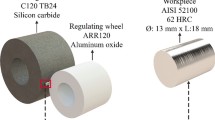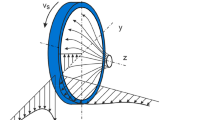Abstract
The centerless grinding process is a fast and efficient process for precision batch and mass production grinding. This process employs wide wheels which allow substantial removal rates, and another additional advantage is that centers are not required as in center grinding. Wide wheels yield to lower wheel wear and higher accuracy for long periods, particularly when using in-process gauging. Many materials and parts of various shapes and sizes are produced by the centerless grinding, in particular, for bearing and automotive industries. In grinding process, the application of metal working fluid (MWF) in order to avoid thermal damages and excessive form deviation are indispensable. In this regard, this work aims to contribute to optimization of machining process through-feed by the study of centerless grinding process under the application of the optimized lubri-cooling technique by a novel multitubular nozzle for various cutting conditions. The multitubular nozzle was employed with emulsion (ME) and compressed air simultaneously (ME + CA) and with conventional nozzle (CN) application for a stock material removal (SMR) of 0.10 and 0.03 mm. All techniques were tested for three different flow rates: 10, 20, and 40 L/min. Surface roughness of the ground surface, roundness deviation, and SEM images of roundness deviation were analyzed. As a result, the ME + CA optimized application produced lower results than CN nozzles in general and the increase of surface roughness values is also produced by higher feed rate values which results in thicker chips in grinding process.





Similar content being viewed by others
References
Jiang JL, Ge PQ, Bi WB et al (2013) 2D/3D ground surface topography modeling considering dressing and wear effects in grinding process. Int J Mach Tools Manuf 74:29–40. https://doi.org/10.1016/J.IJMACHTOOLS.2013.07.002
Lopes JC, Garcia MV, Valentim M et al (2019) Grinding performance using variants of the MQL technique: MQL with cooled air and MQL simultaneous to the wheel cleaning jet. Int J Adv Manuf Technol 105:4429–4442. https://doi.org/10.1007/s00170-019-04574-5
Daniel DM, Ávila BN, Garcia MV et al (2020) Grinding comparative between ductile iron and austempered ductile iron under CBN wheel combined to abrasive grains with high and low friability. Int J Adv Manuf Technol. https://doi.org/10.1007/s00170-020-05787-9
Otaghvar MH et al (2019) Optimization of centerless through-feed grinding using 3D kinematic simulation. Procedia CIRP 79:308–312
Krajnik P et al (2008) Simulation of workpiece kinematics in centreless throughfeed grinding. In: Manufacturing Systems and Technologies for the New Frontier. Springer, London, p. 455–458
Barrenetxea D et al (2012) Model-based assistant tool for the setting-up and optimization of centerless grinding process. Mach Sci Technol 16(4):501–523
Zhou SS, Lindsay RP (1997) Improving workpiece roundness through centerless grinding cycle optimization. CIRP Ann 46(1):217–222
Benedicto E, Carou D, Rubio EM (2017) Technical, economic and environmental review of the lubrication/cooling systems used in machining processes. In: Procedia Engineering The Author(s), pp. 99–116. https://doi.org/10.1016/j.proeng.2017.04.075
Irani RA, Bauer RJ, Warkentin A (2005) A review of cutting fluid application in the grinding process. Int J Mach Tools Manuf 45(15):1696–1705
Lopes JC, Fragoso KM, Garcia MV et al (2019) Behavior of hardened steel grinding using MQL under cold air and MQL CBN wheel cleaning. Int J Adv Manuf Technol 105:4373–4387. https://doi.org/10.1007/s00170-019-04571-8
Debnath S, Reddy MM, Yi QS (2016) Influence of cutting fluid conditions and cutting parameters on surface roughness and tool wear in turning process using Taguchi method. Measurement 78:111–119. https://doi.org/10.1016/J.MEASUREMENT.2015.09.011
Debnath S, Reddy MM, Yi QS (2014) Environmental friendly cutting fluids and cooling techniques in machining: a review. J Clean Prod 83:33–47. https://doi.org/10.1016/j.jclepro.2014.07.071
Javaroni RL et al (2020) Evaluation of a cooled wheel cleaning jet in minimum quantity lubrication grinding process. Int J Adv Manuf Technol 111(5):1303–1317
Da Silva AE et al (2020) Behavior of austempered ductile iron (ADI) grinding using different MQL dilutions and CBN wheels with low and high friability. Int J Adv Manuf Technol 107(11):4373–4387
Silva LR, Corrêa ECS, Brandão JR, de Ávila RF (2013) Environmentally friendly manufacturing: behavior analysis of minimum quantity of lubricant – MQL in grinding process. J Clean Prod 103287. https://doi.org/10.1016/J.JCLEPRO.2013.01.033.
Ozcelik B, Kuram E, Huseyin Cetin M, Demirbas E (2011) Experimental investigations of vegetable based cutting fluids with extreme pressure during turning of AISI 304L. Tribol Int 44:1864–1871. https://doi.org/10.1016/J.TRIBOINT.2011.07.012
Neto LMG, Rodriguez RL, Lopes JC, Ribeiro FSF, Królczyk GM, de Ângelo Sanchez LE, de Mello HJ, Bianchi EC (2022) Application of optimized lubri-cooling technique in through-feed centerless grinding process of bearing steel SAE 52100. Int J Adv Manuf Technol 120(1):515–526. https://doi.org/10.1007/s00170-022-08686-3
Kuchle A (2009) Manufacturing processes: grinding, honing, lapping. Springer
Hashimoto F, Gallego I, Oliveira JF, Barrenetxea D, Takahashi M, Sakakibara K, Stålfelt H-O, Staad G, Ogawai K (2012) Advances in centerless grinding technology. CIRP ann 61(2):747–770. https://doi.org/10.1016/j.cirp.2012.05.00
Setti D, Sinha MK, Ghosh S, Venkateswara Rao P (2015) Performance evaluation of Ti–6Al–4V grinding using chip formation and coefficient of friction under the influence of nanofluids. Int J Mach Tools Manuf 88:237–248. https://doi.org/10.1016/j.ijmachtools.2014.10.005
Bordin A, Sartori S, Bruschi S, Ghiotti A (2017) Experimental investigation on the feasibility of dry and cryogenic machining as sustainable strategies when turning Ti6Al4V produced by additive manufacturing. J Clean Prod 142:4142–4151. https://doi.org/10.1016/j.jclepro.2016.09.209
Jawahir IS et al (2016) Cryogenic manufacturing processes. CIRP Ann 65(2):713–736
Reddy PP, Ghosh A (2014) Effect of cryogenic cooling on spindle power and G-ratio in grinding of hardened bearing steel. Procedia Mater Sci 5:2622–2628
Bianchi EC, De Aguiar PR, Da Silva LR, Canarim RC (2013) Application of minimum quantity lubrication in grinding. Sustain Manuf 6914:111–172. https://doi.org/10.1002/9781118621653.ch4
Lopes JC et al (2019) Grinding performance using variants of the MQL technique: MQL with cooled air and MQL simultaneous to the wheel cleaning jet. Int J Adv Manuf Technol 105(10):4429–4442
De Moraes DL et al (2021) Advances in precision manufacturing towards eco-friendly grinding process by applying MQL with cold air compared with cooled wheel cleaning jet. Int J Adv Manuf Technol 113(11):3329–3342
Silva LR et al (2013) Environmentally friendly manufacturing: behavior analysis of minimum quantity of lubricant-MQL in grinding process. J Clean Prod. https://doi.org/10.1016/j.jclepro.2013.01
Saini S, Ahuja IS, Sharma VS (2012) Residual stresses, surface roughness, and tool wear in hard turning: a comprehensive review. Mater Manuf Process 27(6):583–598
Mao C et al (2012) Investigation of grinding characteristic using nanofluid minimum quantity lubrication. Int J Precis Eng Manuf 13(10):1745–1752
Rowe WB (2013) Principles of modern grinding technology. William Andrew
De Martini Fernandes L et al (2018) Comparative analysis of two CBN grinding wheels performance in nodular cast iron plunge grinding. Int J Adv Manuf Technol 98(1):237–249
De Souza RR et al (2021) Effect of grinding with different CBN grains applied to austempered ductile iron linked to quality and industrial cost. Int J Adv Manuf Technol 113(3):807–820
Ramesh K, Huang H, Yin L (2004) Analytical and experimental investigation of coolant velocity in high speed grinding. Int J Mach Tool Manuf 44(10):1069–1076
Bianchi EC, Rodriguez RL, Hildebrandt RA, Lopes JC, de Mello HJ, da Silva RB, de Aguiar PR (2018) Plunge cylindrical grinding with the minimum quantity lubrication coolant technique assisted with wheel cleaning system. Int J Adv Manuf Technol 95:2907–2916. https://doi.org/10.1007/s00170-017-1396-5
Krabacher EJ (1959) Factors influencing the performance of grinding wheel. Trans Amer Soc Mech Engrs Series B J Eng forind 81:187
Lopes JC, Ventura CEH, Rodriguez RL, Talon AG, Volpato RS, Sato BK, de Mello HJ, Aguiar PR, Bianchi EC (2018) Application of minimum quantity lubrication with addition of water in the grinding of alumina. Int J Adv Manuf Technol 97:1951e1959. https://doi.org/10.1007/s00170-018-2085-8
Rodriguez RL, Lopes JC, Garcia MV, Fonteque Ribeiro FS, Diniz AE, de Ângelo Sanchez LE, de Mello HJ, de Aguiar PR, Bianchi EC (2021) Application of hybrid eco-friendly MQL+WCJ technique in AISI 4340 steel grinding for cleaner and greener production. J Clean Prod 124670:124670. https://doi.org/10.1016/j.jclepro.2020.124670
Rodriguez RL, Lopes JC, Hildebrandt RA, Perez RRV, Diniz AE, de Angelo Sanchez LE, Rodrigues AR, de Mello HJ, de Aguiar PR, Bianchi EC (2019) Evaluation of grinding process using simultaneously MQL technique and cleaning jet on grinding wheel surface. J Mater Process Technol 271:357e367. https://doi.org/10.1016/j.jmatprotec.2019.03.019
Yoshimura H, Itogawa F, Nakamura T, Niwa K (2005) Development of nozzle system for oil-on-water droplet metalworking fluid and its application to practical production line. JSME Int J 48(4):723–729. https://doi.org/10.1299/jsmec.48.723
Sato BK, Lopes JC, Diniz AE, Rodrigues AR, de Mello HJ, Sanchez LEA, Aguiar PR, Bianchi EC (2020) Toward sustainable grinding using minimum quantity lubrication technique with diluted oil and simultaneous wheel cleaning. Tribol Int 147:106276. https://doi.org/10.1016/j.triboint.2020.106276
Bianchi EC, Sato BK, Sales AR, Lopes JC, de Mello HJ, de Angelo Sanchez LE, Diniz AE, Aguiar PR (2018) Evaluating the effect of the compressed air wheel cleaning in grinding the AISI 4340 steel with CBN and MQL with water. Int J Adv Manuf Technol 95:2855–2864. https://doi.org/10.1007/s00170-017-1433-4
Sato BK, Lopes JC, Diniz AE, Rodrigues AR, de Mello HJ, Sanchez LEA, Aguiar PR, Bianchi EC (2020) Toward sustainable grinding using minimum quantity lubrication technique with diluted oil and simultaneous wheel cleaning. Tribol Int 147:106276. https://doi.org/10.1016/j.triboint.2020.106276
Debnath S, Reddy MM, Yi QS (2014) Environmental friendly cutting fluids and cooling techniques in machining: a review. J Clean Prod 83:33e47. https://doi.org/10.1016/j.jclepro.2014.07.071
Guo C, Shi Z, Attia H, Mcintosh D (2007) Power and wheel wear for grinding nickel alloy with plated CBN wheels. CIRP Ann - Manuf Technol. https://doi.org/10.1016/j.cirp.2007.05.079
Acknowledgements
The authors thank Schaeffler Technologies AG & Co for the support to this work. The authors also thank the São Paulo Research Foundation (FAPESP) and CAPES (Coordination for the Improvement of Higher Level Education Personnel).
Author information
Authors and Affiliations
Contributions
LMGN: writing—original draft; writing—review and editing; visualization; conceptualization; formal analysis; investigation; validation. RLR: writing—original draft; writing—review and editing; visualization; conceptualization; formal analysis; investigation; validation. JCL: writing—original draft; resources; conceptualization; methodology; project administration. FSFR: writing—original draft; writing—review and editing; visualization; conceptualization. DLdM: writing—review and editing; conceptualization. LEdAS: writing—review and editing; conceptualization; supervision. HJdM: conceptualization; methodology; formal analysis; investigation; validation. ECB: funding acquisition; conceptualization; resources; supervision; project administration.
Corresponding author
Ethics declarations
Ethical aproval
The authors declare that this manuscript was not submitted to more than one journal for simultaneous consideration. Also, the submitted work is original and not have been published elsewhere in any form or language.
Consent to participate and publish
The authors declare that they participated in this paper willingly and the authors declare to consent to the publication of this paper.
Conflict of interest
The authors declare no competing interests.
Additional information
Publisher's note
Springer Nature remains neutral with regard to jurisdictional claims in published maps and institutional affiliations.
Rights and permissions
Springer Nature or its licensor (e.g. a society or other partner) holds exclusive rights to this article under a publishing agreement with the author(s) or other rightsholder(s); author self-archiving of the accepted manuscript version of this article is solely governed by the terms of such publishing agreement and applicable law.
About this article
Cite this article
Neto, L.M.G., Rodriguez, R.L., Lopes, J.C. et al. Evaluating the optimized lubri-cooling technique for various cutting conditions in through-feed centerless grinding process. Int J Adv Manuf Technol 125, 3465–3473 (2023). https://doi.org/10.1007/s00170-023-10933-0
Received:
Accepted:
Published:
Issue Date:
DOI: https://doi.org/10.1007/s00170-023-10933-0




